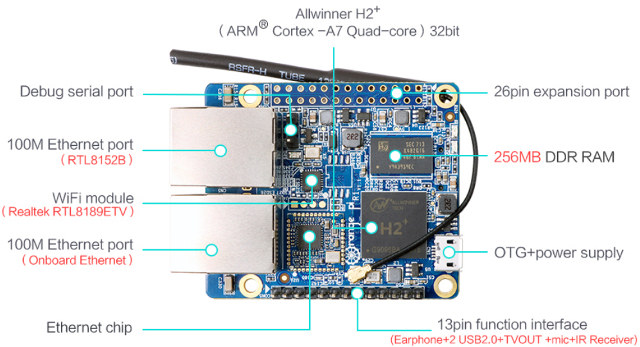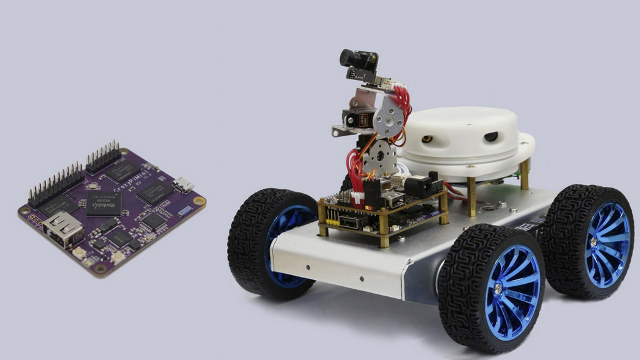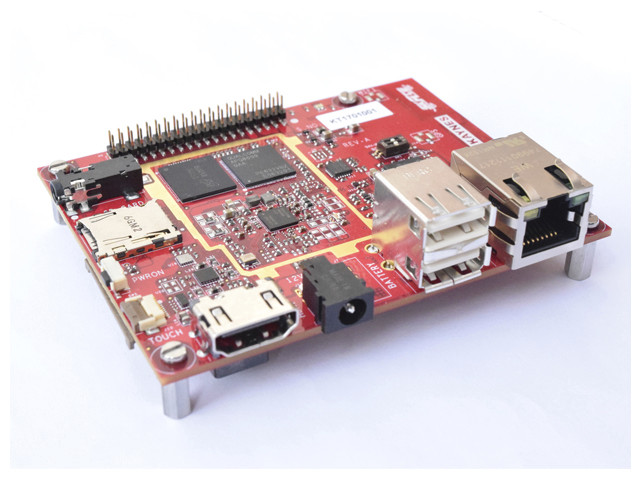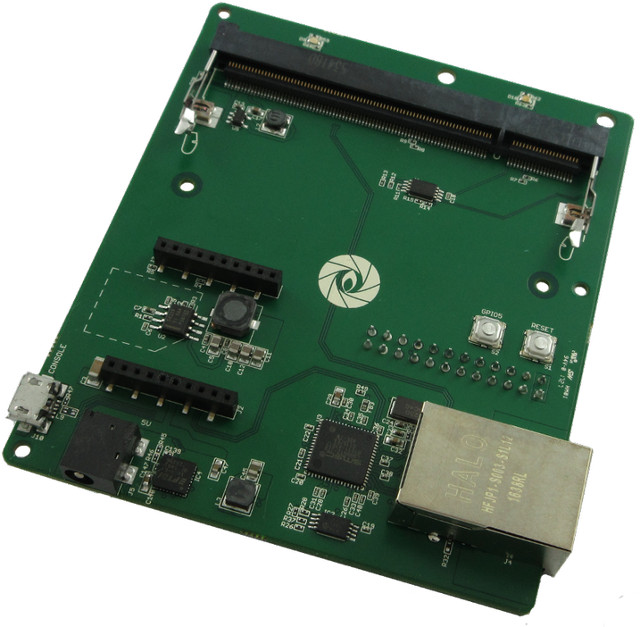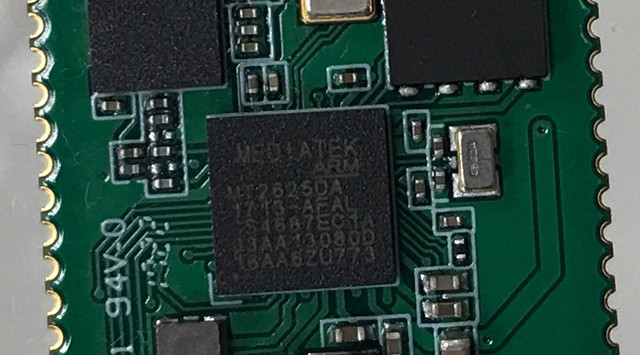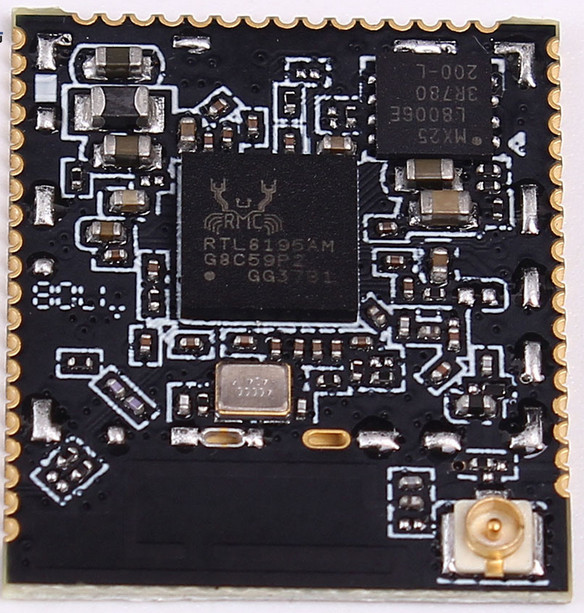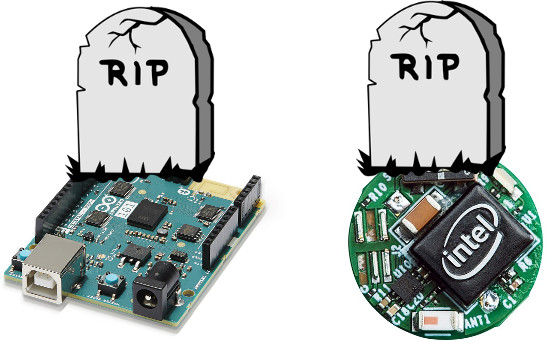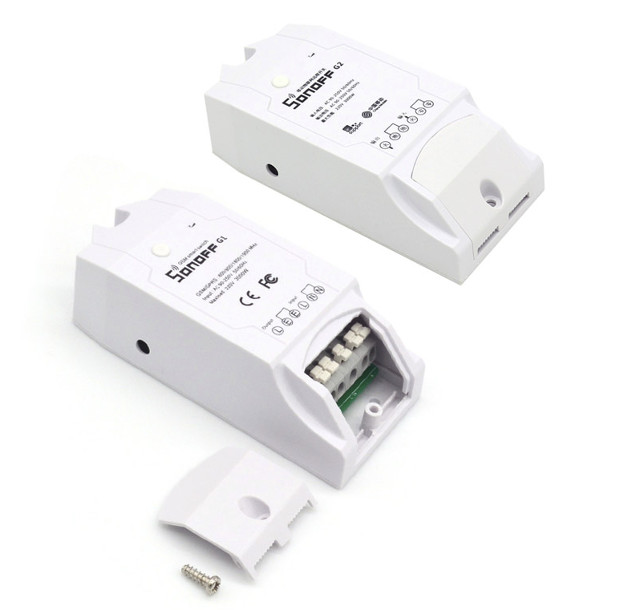Shenzhen Xunlong has introduced the new Orange Pi R1 board with Allwinner H2+ quad core Cortex A7 processor that’s a bit different from their other models, as it includes two 10/100M Ethernet port, and should be suitable for intelligent controllers, or simple IoT gateways. Orange Pi R1 board specifications: SoC – Allwinner H2(+) quad core Cortex A7 processor @ 1.2 GHz with Mali-400MP2 GPU System Memory – 256 DDR RAM Storage – micro SD card slot, 16 MB SPI flash Connectivity – 2x 10/100M Ethernet (including on via RTL8152B USB to Ethernet) + 802.11 b/g/n WiFi (Realtek RTL8189ETV) with u.FL antenna connector and external antenna USB – 1x micro USB OTG port Expansion headers Unpopulated 26-pin “Raspberry Pi B+” header 13-pin header with headphone, 2x USB 2.0, TV out, microphone and IR receiver signals Debugging – 3-pin header for serial console Power Supply – 5V via micro USB port Dimensions […]
CrazyPi Board Runs Ubuntu and ROS on Rockchip RK3128 SoC for Robotics & IoT Projects (Crowdfunding)
CrazyPi is a maker board powered by Rockchip RK3128 quad core Cortex A7 processor that can take various magnetically connected modules such as LIDAR, gimbal, 4G LTE, etc.., and runs both Ubuntu and ROS (Robot Operating System) for DIY robotics & IoT projects. CrazyPi main board specifications: SoC – Rockchip RK3128 quad core Cortex A7 processor @ 1.2 GHz with ARM Mali GPU MCU – ARM Cortex-M3 @ 72 MHz System Memory – 1GB DDR3L @ 1066 MHz Storage – 16GB eMMC flash pre-loaded with Ubuntu and ROS Connectivity – 802.11 a/b/g/n WiFi @ 150 Mbps, Bluetooth 4.0 USB – 1x USB 2.0 host port Expansion Headers – Two headers with a total of 36-pin exposing 1x HDMI, 1x speaker, 1x microphone, 3x PWM, 1x I2C, 1x UART, 1x SPDIF, 1x SPI, 1x USB Power Supply – 5V via micro USB port ? Dimensions – Smaller than credit card The […]
SKATE-212 Snapdragon 212 Development Kit with 7″ Display is now available for $349
Last month, I wrote about two boards based on Snapdragon 212 processor that can be used for smart speakers, IoT applications, industrial automation, etc..: Intrinsyc Open-Q 212 SBC selling for $595 without LCD, and Kaynes Technology SKATE-212. We did not have that much information about the latter at the time, but the company has now published some photos, more details, and revealed pricing. SKATE-212 single board computer specifications: SoC – Qualcomm Snapdragon 212 quad core Cortex A7 @up to 1.3GHz with Adreno 304 GPU supporting OpenGL ES 3.0, OpenCL, DirectX System Memory – 1 GB LPDDR3 (Expandable upto 2GB) Storage – 8 GB eMMC flash (Expandable up to 16GB) + micro SD slot Video Output / Display – 7″ capacitive touchscreen, full size HDMI port (Only one or the other can be used at a given time) Connectivity – 10/100M Ethernet, 802.11 b/g/n WiFi + Bluetooth 4.x LE, GPS with […]
Gumstix Pi Conduit Gateway Board Leverages Raspberry Pi Compute Module, Off-the-Shelf LoRa and Cellular Modules
Gumstix has designed Pi Conduit Gateway baseboard for both the Raspberry Pi Compute Module and RisingRF RHF0M301 LoRa gateway module, in order to create a Linux based LoRa gateway that can optionally support LTE or other cellular connectivity via NimbeLink Skywire cellular modem. Conduit Pi LoRa Gateway board specifications: 200-pin SO-DIMM connector for Raspberry Pi Compute Module / Raspberry Pi 3 Compute Module (CM3 / CM3L) Headers for RisingRF RHF0M301 LoRa Module NimbeLink Skywire 2G/3G/4G cellular modem connector Low profile 10/100M Ethernet jack (implemented via USB 2.0) USB – 1x micro USB port for debugging via an FTDI USB to TTL chip Misc – User (GPIO5) and reset buttons Power Supply – 5V via power barrel The board was designed using Geppetto, which means you should be able to customize it to your needs by modifying it the original design in a web browser, and order your brand new custom […]
Mediatek MT2625 NB-IoT SoC is Designed for Cellular IoT Devices working Worldwide
Mediatek has recently unveiled MT2625 SoC based on an ARM Cortex-M core, equipped with an NB-IoT “WorldMode” modem allowing for a single design worldwide, and supporting the latest 3GPP Release 14 (LTE Cat NB2) specification. Mediatek MT2625 specifications: CPU – ARM Cortex-M @ up to 104 MHz with FPU Embedded Memory – 4MB PSRAM Storage – 4MB NOR Flash Connectivity NB-IoT compatible with 3GPP Release 14 Full frequency band (450MHz to 2.1GHz) of 3GPP R13 (NB1) and R14 (NB2) standards Integrated baseband, RF, and modem DSP Peripherals – I2C, I2S, PCM, SDIO, UART Power Supply – Integrated PMU The solution will be found in products for worldwide transportation, municipal use, and consumer products, with a much longer battery life compared to existing devices relying on other 2G/3G/4G standards. According to the press release, one of the first module based on MT2625 has been designed in collaboration with China Mobile, integrates […]
Realtek RTL8195AM Ameba WiFi + NFC Module Sells for $9 Shipped
Last year, Realtek Ameba IoT SoCs and development kits launched with boards such as Ameba Arduino, and later, the family got some buzz thanks to $2 RTL8710AF modules like Pine64 Padi IoT stamp, which looked competitive priced against ESP8266 SoC, and featuring an ARM Cortex-M3 core. Back to 2017, ESP8266 appears to still be the preferred platform for makers, and the community around Reatek Ameba processor is relatively small, but maybe the solutions are being integrated into commercial products rather than hobbyists project. Today, as I browsed the web, I noticed that are also some Realtek RTL8195AM module with WiFi, and NFC starting with an “Realtek Ameba-RTL8195AM WiFi & NFC Module” I first found on DFrobot for $15 per unit, but after spending a bit more time searching, I ended finding what looks like the same model for $8.99 including shipping on IC Station. RTL8195AM module (MJIOT-AMB-02) specifications: SoC – […]
Intel Curie Module, Arduino 101 Board Are Being Discontinued (Too)
Intel seems to have completely given up on its efforts to bring products specific to the Internet of Things. After discontinuing Intel Edison, Galileo and Joule boards & modules last month, forcing companies to look for alternatives, the company has now issued product discontinuance / end-of-life notices for Intel Curie Module and Arduino 101 board, itself based on the Curie module. The two product change notification notice can be found below for: Select Intel Curie Module Products – PDF Select Intel Arduino 101 Products – PDF The use of the word “Select” would normally mean some versions of the module and board won’t be affected, but I fail to see which ones here, as AFAIK there’s only one Arduino 101 board, and two variants of Curie modules, all three to be discontinued. Arduino 101 will be phased out faster with the following milestones: July 17, 2017 – Product Discontinuance Program […]
Sonoff G1 AC Powered Smart Power Switch Works Over 2G GSM/GPRS
Today, I’ve searched for AC powered wireless switched similar to Sonoff devices, but with ESP32 instead in order to get WiFi and Bluetooth, since the latter is better to use with a battery powered buttons. I did find a DC powered board, but no AC powered ones yet. However, as I visited ITEAD website to check if they had anything of the sort, I discovered they had a new model called Sonoff G1, similar to Sonoff TH16, but instead of using WiFi, you can use 2G GSM/GPRS to control the switch remotely. Sonoff G1 specifications: Wireless Module – ST86 quad band GSM/GPRS module GSM/GPRS connectivity GSM850, EGSM900, DCS1800 and PCS1900 MHz support GPRS multi-slot class 10, GPRS mobile station class B 1.8V, 3V SIM card slot Transmit power: Class 4 (2W): GSM850, EGSM900; Class 1 (1W): DCS1800, PCS1900 Relay – Up to 16A (3000 Watts max) Terminals – 6 terminals […]


